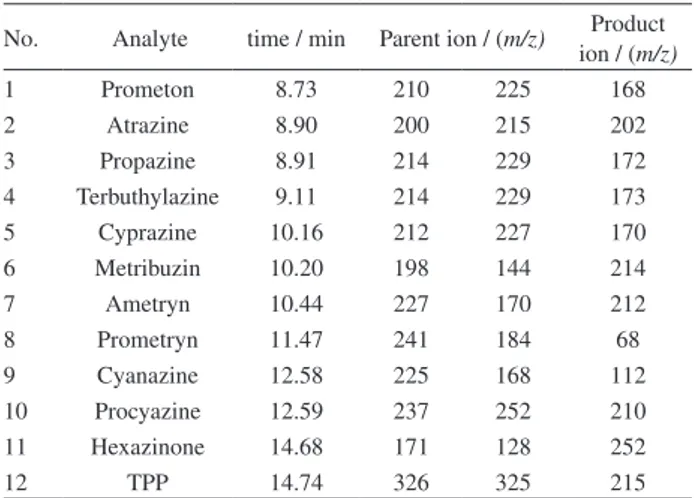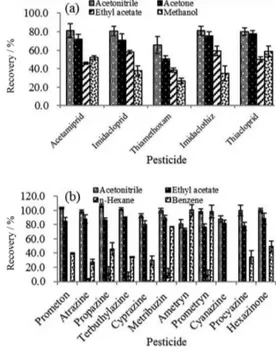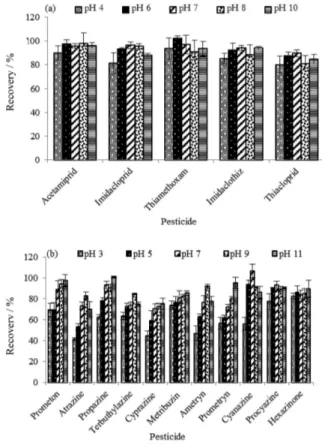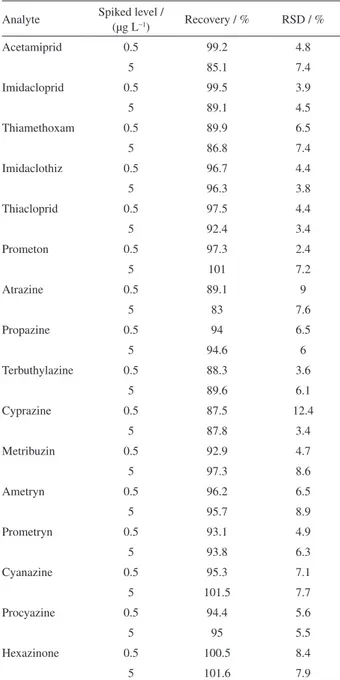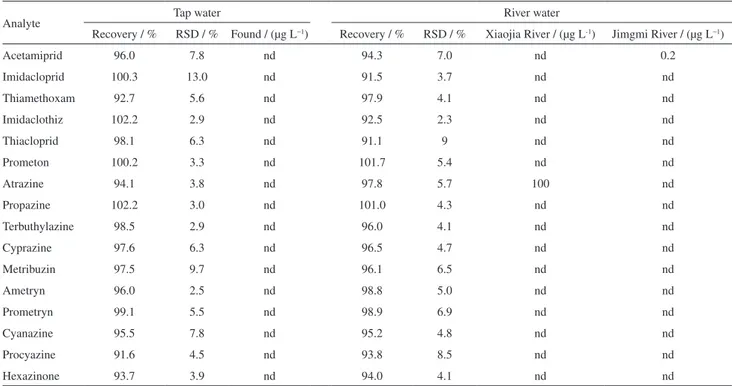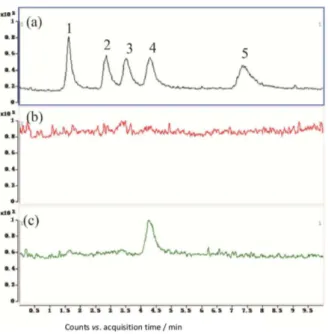Article
J. Braz. Chem. Soc., Vol. 26, No. 1, 131-139, 2015. Printed in Brazil - ©2015 Sociedade Brasileira de Química 0103 - 5053 $6.00+0.00
A
*e-mail: mayongqiang@cau.edu.cn, yanlidu@126.com
Evaluation of Graphene for Dispersive Solid-Phase Extraction of Triazine and
Neonicotine Pesticides from Environmental Water
Xiao Li Wu,a Lixuan Meng,a Yanhua Wu,a Yan-Yeung Luk,b Yongqiang Ma*,a and Yanli Du*,c
aCollege of Science, China Agricultural University, 100193 Beijing, PR China
bDepartment of Chemistry, Syracuse University, 13244 Syracuse-NY, United States
cPlant Science and Technology College, Beijing University of Agriculture, 102206 Beijing, PR China
Neste trabalho, grafeno foi usado na extração em fase sólida dispersiva de 11 herbicidas triazina e 5 inseticidas neonicotina da água. As condições de extração como quantidade de grafeno, solvente de dessorção e pH da solução foram otimizados. Nas condições otimizadas, um enriquecimento de alta eficiência foi alcançado na análise quantitativa dos pesticidas. Triazinas e neonicotinas foram determinadas por espectrometria de massas-cromatografia gasosa (GC-MS) e cromatografia líquida de alta eficiência acoplada à espectrometria de massas (LC-MS/MS), respectivamente. Os resultados indicaram que o grafeno foi um excelente adsorvente na adsorção de pesticidas. A recuperação dos pesticidas foi 83,0-108,9% com desvio padrão relativo (RSD) entre 2,4% e 12,3%. Os limites de detecção (LODs) variaram entre 0,03 µg L−1 e 0,40 µg L−1. Finalmente, o método
proposto foi aplicado na análise de amostras reais, como água de torneira e de rio.
In this work, graphene was used for dispersive solid-phase extraction of 11 triazine herbicides and 5 neonicotine insecticides from water. The extraction conditions such as the amount of graphene, the desorption solvent and the solution pH were optimized. Under the optimal conditions, high efficient enrichment was achieved for the quantitative analysis of the pesticides. Triazines and neonicotines were determined by gas chromatograph-mass spectrometer (GC-MS) and high performance liquid chromatography electrospray tandem mass spectrometry (LC-MS/MS), respectively. The results indicated that graphene was an excellent adsorbent for the adsorption of pesticides. The recoveries of the pesticides were 83.0-108.9% with relative standard deviation (RSD) between 2.4% and 12.3%. The limits of detection (LODs) ranged from 0.03 µg L−1 to 0.40 µg L−1.
Finally, the proposed method was applied for real sample analysis, such as tap and river water.
Keywords: graphene, triazines, neonicotines, fast extraction
Introduction
In recent years, herbicides and insecticides have been broadly used for increasing agricultural production and quality. For example, triazines were important herbicides used in weed control and neonicotine insecticides have been widely used due to their low toxicity and high activity against insects.1,2 However, the abuse of these
compounds has resulted in contamination of surface water, groundwater, soil and air.3 To assure water safety
and quality, it is of paramount importance for developing sensitive, selective, rapid and cost-effective methods for monitoring the presence of pesticides.
Pretreatment is required for trace analysis of pesticides in water samples. The most commonly used pretreatment methods for water sample were solid-phase extraction (SPE),4,5 matrix solid-phase dispersion extraction (MSPE),6
and solid-phase micro extraction (SPME).7 For all these
methods, the adsorbent materials, which determine the selectivity and sensitivity of the methods, are crucial components. The most widely used adsorbent are C18 chemically-bonded to silica,8-10 carbon black,11,12 and
polymeric resins.13-16 Carbon nano-materials represent a
novel class of adsorbent with large specific surface area, including fullerenes,17,18 carbon nanotubes (CNTs),6,19,20 and
graphene.19 Graphene has attracted tremendous attention
since it was discovered in 2004. It has a large delocalized
(about 2630 m2 g−1),21 which make it very attractive as an
adsorbent material for the adsorb of both non-polar and polar compounds.22-25 Besides, graphene and
graphene-based materials also have been reported with good performance for the adsorption of heavy metals,26-29 organic
dyes,30-33 sulfonamide antibiotics,34 and pesticides,35,36 and
phthalic acid esters (PAEs).37
In this work, graphene was successfully used for effective dispersive solid-phase extraction of 11 triazines and 5 neonicotines from environmental water. The two chemical classes of pesticide were determined by gas chromatograph-mass spectrometer (GC-MS) and high performance liquid chromatography electrospray tandem mass spectrometry (LC-MS/MS), respectively. The method was faster and simpler compared with other methods. Furthermore, the amount of adsorbent used was much lower than other methods.
Experimental
Reagents and solutions
Standards of all pesticides and triphenyl phosphate (TPP) (99%) used as internal standard with purity higher than 98% were purchased from J&K Scientific Ltd (Beijing, China) and were maintained at 4 °C in the dark.
Chromatographic grade acetonitrile, acetone, n-hexane, methanol and ethyl acetate were purchased from MREDA Co., Ltd (Beijing, China). Analytical reagent grade anhydrous sodium chloride (NaCl), potassium permanganate (KMnO4),
hydrazine hydrate (85%), ammonia solution (25%), sulphuric acid (98%), hydrochloric acid (38%) and 20% hydrogen peroxide (H2O2) were purchased from Beijing Chemical
Works (Beijing, China). Ultrapure water was obtained from a Milli-Q water purification system (Millipore, Billerica, MA, USA). Expandable graphite was obtained from Qingdao Hensen Graphite Co., Ltd (Qingdao, China).
Tap water samples were collected from a water tap in our lab (Beijing, China). River water samples were collected from the top layer (0-50 cm) of Jingmi River and Xiaojiahe River (Beijing, China). All samples were cooled in a refrigerator (4 °C) during transport to the laboratory.
Preparation of graphene
Graphene oxide (GO) was synthesized from expandable graphite using a modified Hummers method,38 and then
was reduced via chemical reduction to prepare graphene,39
which was described detailed in our previous work.37
Briefly, GO was reduced to graphene by hydrazine hydrate in an oil bath at 80 °C for 24 h, then was purified with
ultrapure water. The obtained graphene was dispersed in water with a concentration of 3 mg mL−1, which was
determined by freeze drying.
Instrumentation
The analysis of neonicotines was achieved using an Agilent 1200 HPLC series and an Agilent 6410B triple-quadrupole mass spectrometer equipped with an electrospray (ESI) ionization interface (Agilent Technologies, USA). For instrument control, masshunter workstation software data acquisition for triple quad B.02.01 (B2043.12) and qualitative analysis version B.03.01/build 3.1.346.0 were used for data acquisition and processing. A reversed phase ZORBAX SB-C18 column (1.8 µm particle size, 2.1 mm × 50 mm) from Agilent technologies was employed for HPLC separation at 30 °C. The mobile phase consisted of methanol and water (1:3, v/v). The flow rate was 0.3 mL min−1. The source
temperature was 100 °C and desolvation gas temperature was 300 °C. The nebulizer gas (N2) were set at 10.0 L min
−1 and
35.0 psi. The quantitative parameters were showed in Table 1.
The analysis of triazines was performed by an Agilent 6890N GC-5975B MSD (Agilent Technologies, USA). The separation was achieved on a fused silica capillary column (HP-5, 30 m × 0.25 mm i.d., with 0.25 µm film thickness). The column temperature was programmed at 120 °C for 1 min initially. Then raised to 175 °C at rate of 35 °C min−1 and held for 1 min. Afterwards, it was increased
to 215 °C at a rate of 35 °C min−1 and held for 1 min. Finally,
increased to 260 °C at a rate of 35 °C min−1, and kept for
5 min. The injector temperature, ion source temperature and quadrupole temperature were 290 °C, 230 °C and 280 °C, respectively. Helium of high purity flow rate: 1 mL min−1.
The retention times, quantitative ions and qualitative ions of 11 triazines were shown in Table 2.
Procedure for the extraction of the pesticides
Graphene dispersive-SPE
Firstly, an appropriate amount of graphene was added into 40 mL water sample in a centrifuge tube. Secondly, Table 1. HPLC-MS/MS analysis of 5 neonicotine pesticides
No. Analyte time / min Parent ion / (m/z) Product ion / (m/z)
1 Thiamethoxam 1.61 292 211a, 181 2 Imidacloprid 2.85 256 209, 175a 3 Imidaclothiz 3.49 262 181a, 122 4 Acetamiprid 4.30 223 126a, 56
5 Thiacloprid 7.32 253 186, 126a
to trap the analytes, the mixture was vortexed for 1 min. Subsequently, graphene was isolated from the solution by centrifugation (3800 r min−1, 5 min). The supernatant was
discarded. Finally, the target compounds were adsorbed on graphene. In this procedure, the amount of graphene and the pH of the solution were tested, which were shown in Table 3.
The fast desorption procedure
In this procedure, desorption solvent was added and vortexed for 1 min to desorb the target analytes. In the meantime, NaCl (2 g) was used for salting out. Subsequently, the mixture was centrifuged for 5 min (3800 r min−1).
Finally, in order to avoid extracting the bottom graphene as far as possible and concentrate the analytes, 4 mL of the upper organic phase was concentrated by evaporator and dissolved in 1 mL acetonitrile, then was transferred into a 1.5 mL vial for determination. In this procedure, the types of desorption solvent and the volume of desorption were optimized (Table 3).
Results and Discussion
In order to obtain optimized extraction conditions, the adsorption and desorption conditions, including the
amount of graphene, the desorption solvent and the pH of the solution were tested. The pesticides were all spiked at 1 µg L−1 with 5 replicates.
The amount of graphene
The amount of adsorbent, the key factor of the extraction procedure, had a significant effect on the extraction efficiency. The graphene used in this work was dispersed in ultrapure water with a final concentration of 3 mg mL−1.
Different volumes of graphene were tested for the two chemical classes of pesticides in neutral solution, and 10 mL of acetonitrile was used for desorption.
4 mL, 5 mL, 6 mL, 7 mL and 8 mL of graphene were tested for adsorption of neonicotines. The results shown in Figure 1a indicated that the recoveries of 5 neonicotines were the hightest when 6 mL of graphene was used. However, more graphene results in lower recoveries. It may be because the recoveries of the analytes were affected by both graphene and eluting solvent, which means that when the amount of graphene was increased and the eluting solvent remained unchanged, the recoveries of some pesticides may have decreased.
Besides, 1 mL, 2 mL, 3 mL, 4 mL and 5 mL of graphene were used for the adsorption of trazines. The results (Figure 1b) showed that the recoveries of most pesticides increased with the increase of the amount of graphene. With the recoveries of pesticides and the amount of graphene taken into account, 3 mL of graphene was chosen for the adsorption of trazines.
Selection of desorption solvent
The desorption solvent is another prime factor that affects the extraction efficiency. 10 mL of different desorption solvents were used for desorption in neutral solution, without adjusting, with optimized amount of graphene.
Acetonitrile, ethyl acetate, acetone, methanol were tested for 5 neonicotines. It indicated that when acetonitrile was used for desorption of the 5 neonicotine insecticides, the recoveries (65.8-81.4%) were higher than the other 3 Table 2. Retention time, qualitative ions and quantitative ions for
GC/MS analysis of 11 triazine pesticides
No. Analyte time / min Parent ion / (m/z) Product
ion / (m/z)
1 Prometon 8.73 210 225 168
2 Atrazine 8.90 200 215 202
3 Propazine 8.91 214 229 172
4 Terbuthylazine 9.11 214 229 173
5 Cyprazine 10.16 212 227 170
6 Metribuzin 10.20 198 144 214
7 Ametryn 10.44 227 170 212
8 Prometryn 11.47 241 184 68
9 Cyanazine 12.58 225 168 112
10 Procyazine 12.59 237 252 210
11 Hexazinone 14.68 171 128 252
12 TPP 14.74 326 325 215
Table 3. Conditions studied to optimize the extraction procedure
Condition Neonicotines Triazines
Amount of graphene / mL 4, 5, 6a, 7, 8 1, 2, 3a, 4, 5
Desorption solvent acetonitrile,a ethyl acetate, acetone, methanol acetonitrile,a ethyl acetate. n-hexane, benzene
Desorption solvent volume / mL 4, 6, 7, 8a, 10 6, 8a, 10, 12, 14
pH of the solution 4, 6, 7a, 8, 10 3, 5, 7a, 9, 11
solvents (Figure 2a). The recoveries of 5 neonicotines were 50.6-77.9% when acetone was used. Ethyl acetate and methanol were not chosen because of the relatively low recoveries (26.9-58.8%), therefore, acetonitrile was chosen.
Triazine pesticides are planar analytes, which can easily adsorb on graphene. Consequently, n-hexane with relatively weak polarity and benzene with strong elution ability were chosen besides acetonitrile and ethyl acetate. The results were showed in Figure 2b. When n-hexane was used, the recoveries of 11 trazine herbicides were 0.0-11.9%. For benzene, the recoveries were between 0.0% and 96.8%. Benzene and n-hexane are water-insoluble and the polarity of both was too weak to elute the analytes completely, which result in low recoveries of the analytes. The recoveries of 11 trazine herbicides were 72.7-106.6% when acetonitrile and ethyl acetate were used. Thus, acetonitrile was chosen for relative higher recoveries.
Therefore, acetonitrile was chosen as the final desorption solvent for both trazines and neonicotines.
Selection of desorption solvent volume
Besides the types of desorption solvent, the volume of the solvent can also influence the desorption efficiencies. Acetonitrile was used for desorption in neutral solution with optimized amount of graphene.
4 mL, 6 mL, 7 mL, 8 mL and 10 mL of acetonitrile were tested for the desorption of neonicotine pesticides
(Figure 3a). 6 mL, 8 mL, 10 mL, 12 mL and 14 mL of acetonitrile were tested for the desorption of trazines (Figure 3b). The recoveries showed a growing trend initially with the increase of desorption solvent, and then remained almost unchanged. In order to obtain Figure 1. Selection of the amount of graphene (a) neonicotine pesticides
and (b) triazine pesticides.
Figure 2. Selection of desorption solvent (a) neonicotine pesticides and (b) triazine pesticides.
higher desorption efficiencies and save solvent, 8 mL of acetonitrile was chosen as the final volume for both trazines and neonicotines.
Selection of solution pH
Solution pH plays another important role for the adsorption of the analytes by affecting both the existing forms of the target compounds and the charge species and density on the sorbent surface.32 The solution pH was adjusted by
adding hydrochloric acid or sodium hydroxide solution. In this work, the sample pH was also investigated (Figure 4). The set points were pH 3, 5, 7, 9, 11 for trazines and 4, 6, 7, 8, 10 for neonicotines. The results showed that the solution pH has no significantly influence on the recoveries of neonicotines. In the acidic conditions (pH 3-5), the recoveries of some trazines were unsatisfactory, for example, the recoveries of atrazine and cyprazine were 41.3% and 44.7%, respectively. However, in neutral (pH 7) or alkaline (pH 9-11) conditions, the recoveries were all more than 70%. In conclusion, graphene possess satisfactory absorption performance for both trazines and neonicotines in neutral water system. As most of the environmental water samples were close to neutralization, the extraction procedure was taken without adjusting of pH value.
Validation of the method
Based on the above optimal conditions, one simple and rapid method for the determination of trazines and neonicotines was developed. The linear range, the limit of detection (LOD), the limit of quantitation (LOQ) and the precision of the method were all investigated (Table 4). The linear range for the analytes was in the final extract.
The LODs, which were calculated based on the ratio of signal to noise (S/N = 3), were 0.03-0.4 µg L−1. Calibration
curves were established over the range 0.5-100 µg L−1 for
all pesticides and satisfactory coefficient of determination (R2) (0.9979-0.9998) were obtained. The repeatability of
the method was carried out by five parallel experiments spiked at 0.5, 1 and 5 µg L−1 for neonicotines and 0.5, 5
and 10 µg L−1 for trazines. The recoveries (Table 5) of all
pesticides were 83.0-108.9%, with the relative standard deviation (RSD) between 2.4% and 12.3%, which indicate that graphene has an outstanding adsorption capacity for all targets.
Comparison with SPE
The most commonly used method for the pre-concentration of trazines and neonicotines is SPE.2,40-46
Listed in Table 6 is the comparison of this method with SPE procedure for the enrichment of the two chemical Figure 4. Selection of the solution pH (a) neonicotine pesticides and
(b) triazine pesticides.
Table 4. Linear range, coefficient of determination (R2), LOD and LOQ for all pesticides
Analyte Linear range / (µg L−1) R
2 LOD / (µg L−1)
LOQ / (µg L−1)
Acetamiprid 0.5-100 0.9995 0.10 0.33
Imidacloprid 0.5-100 0.9998 0.05 0.17
Thiamethoxam 0.5-100 0.9993 0.15 0.50
Imidaclothiz 0.5-100 0.9995 0.05 0.17
Thiacloprid 0.5-100 0.9996 0.03 0.10
Prometon 0.5-100 0.9997 0.09 0.30
Atrazine 0.5-100 0.9997 0.12 0.40
Propazine 0.5-100 0.9993 0.15 0.50
Terbuthylazine 0.5-100 0.9996 0.04 0.13
Cyprazine 0.5-100 0.9987 0.25 0.83
Metribuzin 0.5-100 0.9979 0.23 0.77
Ametryn 0.5-100 0.999 0.12 0.40
Prometryn 0.5-100 0.9994 0.09 0.30
Cyanazine 0.5-100 0.9986 0.36 1.20
Procyazine 0.5-100 0.9995 0.40 1.30
classes of pesticide. Although the method developed in our current study did not give prominence to low LODs, it was outstanding in other aspects.
Firstly, the water volume needed for analysis in this method was only 40 mL, which was lower than SPE listed in Table 6, which were more than 100 mL.40,45,46
Secondly, the amount of adsorbent was much lower than other methods. In this method, 3 mL of graphene (3 mg mL−1) was applied for adsorbing trazines and 6 mL
for neonicotines, indicating that 0.018 g of graphene can effectively extract these two chemical classes of pesticide. However, other adsorbents used in SPE procedure were more than 0.1 g.40-46
Thirdly, as for solvent consuming, only 8 mL of acetonitrile was used for desorption in this work. However, for SPE methods, the cartridges should be conditioned with appropriate solvent prior to preconcentration procedure. Besides, the parameters including the kind, the volume, and the flow rate of the solvent should be optimized, which were verbose and expensive.
Fourthly, compared to previously reported SPE methods, our method was a fast and effective extraction method. The extraction procedure including two main steps: fast adsorption and fast desorption procedure, which was completed within 20 min. It was time-saving than SPE methods (more than 20 min).40,41
Analysis of environmental water samples
The repeatability study was carried out by five parallel experiments spiked at 2 µg L−1 for both tap water and river
water. The recoveries were 91.1-102.2%, and the RSDs were all less than 13.0%. This indicated that the water matrixes have no tremendous influence on the recoveries of the pesticides. The proposed method was applied for the analysis of the pesticides in real environmental water samples including tap and river water samples collected in Beijing (shown in Table 7).
The detection of acetamiprid was 0.2 µg L−1 in Jingmi
River and the detection of atrazine was 100 µg L−1 in Xiaojia
River. Other pesticides were not found in river samples. Besides, none of the pesticides were found in tap water. The typical chromatograms of the extracted pesticides were showed in Figure 5-6.
Conclusions
In this study, graphene was used as an adsorbent for effective enrichment of neonicotines and triazines from water. Under the optimal conditions, a fast extraction method including fast adsorption and fast desorption procedure was established. This rapid and simple method has many advantages over other preparation methods, such as less use amount of adsorbent and eluent, easy-operated and time-saving. The results indicated that graphene was an excellent adsorbent material and has a wide application in pesticides analysis.
Acknowledgements
This work was supported by Beijing Municipal Natural Science Foundation (No. KZ201210020019) and National Science Foundation for Fostering Talents in Basic Research of China (No. J1210064).
Table 5. Repeatability study of the method in purified water (n = 5)
Analyte Spiked level /
(µg L−1) Recovery / % RSD / %
Acetamiprid 0.5 99.2 4.8
5 85.1 7.4
Imidacloprid 0.5 99.5 3.9
5 89.1 4.5
Thiamethoxam 0.5 89.9 6.5
5 86.8 7.4
Imidaclothiz 0.5 96.7 4.4
5 96.3 3.8
Thiacloprid 0.5 97.5 4.4
5 92.4 3.4
Prometon 0.5 97.3 2.4
5 101 7.2
Atrazine 0.5 89.1 9
5 83 7.6
Propazine 0.5 94 6.5
5 94.6 6
Terbuthylazine 0.5 88.3 3.6
5 89.6 6.1
Cyprazine 0.5 87.5 12.4
5 87.8 3.4
Metribuzin 0.5 92.9 4.7
5 97.3 8.6
Ametryn 0.5 96.2 6.5
5 95.7 8.9
Prometryn 0.5 93.1 4.9
5 93.8 6.3
Cyanazine 0.5 95.3 7.1
5 101.5 7.7
Procyazine 0.5 94.4 5.6
5 95 5.5
Hexazinone 0.5 100.5 8.4
Table 6. Comparation of this method with other methods
Method Matrix
volume / mL Adsorbent Solvent time / min LOD / (µg L
−1) Ref.
SPE-HPLC 500 0.1 g of MWCNTs 4 mL of methanol > 70
thiamethoxam 0.0061, imidacloprid 0.0054,
acetamiprid 0.0067
2
SPE-HPLC 100 (500 mg × 2.8 mL)
C18 column 7 mL of methanol > 20 imidacloprid 0.5 40
SPE-LC-ES/MS ≥1000 0.5 g of graphitized carbon black
6 mL of methylenechloride / methanol (80:20, v/v)
2 mL of methanol
> 20 atrazine 0.04 nga 41
SPE-HPLC 500 0.1 g of MWCNTs 4 mL of acetonitrile > 70 atrazine, 0.033;
simazine, 0.009 42
SPE-HPLC 250 0.1 g of MWCNTs 10 mL of methanol, > 50 cyanazine 0.015 43
SPE-HPLC 500 0.1 g of MWCNTs
20 mL of methanol, 6mL of
dichloromethane
> 70 prometryn 0.0008 44
SPE-HPLC 100 0.1 g of MWCNTs 4mL of ethyl acetate,
3 mL of methanol > 30 atrazine 0.02 45
SPE-HPLC 100 1.0 g of bamboo
charcoal 20 mL of acetonitrile > 50
simazine 0.1;
atrazine 0.1 46
This work 40 ≤ 6 mL of graphene
(3 mg mL−1) 8 mL of acetonitrile < 20
acetaniprid, 0.10; imidacloprid, 0.05; thiamethoxam, 0.15; imidaclothiz, 0.05; thiacloprid, 0.03; prometon, 0.09; atrazine, 0.12; propazine, 0.15; terbuthylazine, 0.04; cyprazine, 0.25; metribuzin, 0.23; ametryn, 0.12; prometryn, 0.09; cyanazine, 0.36; procyazine, 0.40; hexazinone, 0.26
This work
aThe unit of the concentration was ng.
Table 7. Recoveries (spiked at 2 µg L−1, n = 5) of the two chemical classes of pesticide in tap water, river water and real sample analysis
Analyte Tap water River water
Recovery / % RSD / % Found / (µg L−1) Recovery / % RSD / % Xiaojia River / (µg L-1) Jimgmi River / (µg L−1)
Acetamiprid 96.0 7.8 nd 94.3 7.0 nd 0.2
Imidacloprid 100.3 13.0 nd 91.5 3.7 nd nd
Thiamethoxam 92.7 5.6 nd 97.9 4.1 nd nd
Imidaclothiz 102.2 2.9 nd 92.5 2.3 nd nd
Thiacloprid 98.1 6.3 nd 91.1 9 nd nd
Prometon 100.2 3.3 nd 101.7 5.4 nd nd
Atrazine 94.1 3.8 nd 97.8 5.7 100 nd
Propazine 102.2 3.0 nd 101.0 4.3 nd nd
Terbuthylazine 98.5 2.9 nd 96.0 4.1 nd nd
Cyprazine 97.6 6.3 nd 96.5 4.7 nd nd
Metribuzin 97.5 9.7 nd 96.1 6.5 nd nd
Ametryn 96.0 2.5 nd 98.8 5.0 nd nd
Prometryn 99.1 5.5 nd 98.9 6.9 nd nd
Cyanazine 95.5 7.8 nd 95.2 4.8 nd nd
Procyazine 91.6 4.5 nd 93.8 8.5 nd nd
References
1. Nagaraju, D.; Huang, S. D.; J. Chromatogr. A2007, 1161, 89. 2. Zhou, Q. X.; Ding, Y. J.; Xiao, J. P.; Anal. Bioanal. Chem.2006,
385, 1520.
3. Fernandez-Alvarez, M.; Llompart, M.; Lamas, J. P.; Lores, M.; Garcia-Jares, C.; Cela, R.; Dagnac, T.; J. Chromatogr. A2009,
1216, 2832.
4. Font, G.; Manes, J.; Molto, J. C.; Pico, Y.; J. Chromatogr. A
1993, 642, 135.
5. Molto, J. C.; Pico, Y.; Font, G.; Manes, J.; J. Chromatogr. A
1991, 555, 137.
6. Guan, S. X.; Yu, Z. G.; Yu, H. N.; Song, C. H.; Song, Z. Q.; Qin, Z.; Chromatographia2011, 73, 33.
7. Eisert, R.; Pawliszyn, J.; J. Chromatogr. A1997, 776, 293. 8. Somsen, G. W.; Jagt, I.; Gooijer, C.; Velthorst, N. H.; Brinkman,
U. A. T.; Visser, T.; J. Chromatogr. A1996, 756, 145. 9. Pocurull, E.; Marce, R. M.; Borrull, F.; Chromatographia1995,
41, 521.
10. Chiron, S.; Alba, A. F.; Barcelo, D.; Environ. Sci. Technol.1993,
27, 2352.
11. Sabik, H.; Jeannot, R.; Sauvard, E.; Analysis 2000, 28, 835.
12. DiCorcia, A.; Bellioni, A.; Madbouly, M. D.; Marchese, S.;
J. Chromatogr. A1996, 733, 383.
13. Puig, D.; Barcelo, D.; Anal. Chim. Acta1995, 311, 63. 14. Pocurull, E.; Marce, R. M.; Borrull, F.; J. Chromatogr. A1996,
738, 1.
15. Marce, R. M.; Prosen, H.; Crespo, C.; Calull, M.; Borrull, F.; Brinkman, U. A. T.; J. Chromatogr. A1995, 696, 63.
16. Liska, I.; Brouwer, E. R.; Ostheimer, A. G. L.; Lingeman, H.; Brinkman, U. A. T.; Geerdink, R. B.; Mulder, W. H.; Int. J. Environ. Anal. Chem.1992, 47, 267.
17. Cheng, X. K.; Kan, A. T.; Tomson, M. B.; J. Chem. Eng. Data
2004, 49, 675.
18. Ballesteros, E.; Gallego, M.; Valcarcel, M.; J. Chromatogr. A
2000, 869, 101.
19. Liu, Q.; Shi, J. B.; Zeng, L. X.; Wang, T.; Cai, Y. Q.; Jiang, G. B.; J. Chromatogr. A2011, 1218, 197.
20. Ravelo-Perez, L. M.; Herrera-Herrera, A. V.; Hernandez-Borges, J.; Rodriguez-Delgado, M. A.; J. Chromatogr. A2010, 1217, 2618. 21. Stoller, M. D.; Park, S.; Zhu, Y.; An, J.; Ruoff, R. S.; Nano Lett.
2008, 8, 3498.
22. Zhang, Y. W.; Ma, H. L.; Peng, J.; Zhai, M. L.; Yu, Z. Z.;
J. Mater. Sci.2013, 48, 1883.
23. Pei, Z. G.; Li, L. Y.; Sun, L. X.; Zhang, S. Z.; Shan, X. Q.; Yang, S.; Wen, B.; Carbon2013, 51, 156.
24. Maliyekkal, S. M.; Sreeprasad, T. S.; Krishnan, D.; Kouser, S.; Mishra, A. K.; Waghmare, U. V.; Pradeep, T.; Small2013, 9, 273.
25. Xu, J.; Wang, L.; Zhu, Y. F.; Langmuir2012, 28, 8418. Figure 5. Typical chromatograms of (a) 5 neonicotines spiked at 2 µg L−1
in water sample, (b) tap water sample and (c) Jingmi River water sample. 1, thiamethoxam; 2, imidacloprid; 3, imidaclothiz; 4, acetamiprid; 5, thiacloprid.
26. Chandra, V.; Park, J.; Chun, Y.; Lee, J. W.; Hwang, I. C.; Kim, K. S.; ACS Nano2010, 4, 3979.
27. Hao, L. Y.; Song, H. J.; Zhang, L. C.; Wan, X. Y.; Tang, Y. R.; Lv, Y.; J. Colloid Interface Sci.2012, 369, 381.
28. Kyzas, G. Z.; Travlou, N. A.; Deliyanni, E. A.; Colloids Surf., B 2014, 113, 467.
29. Pastewka, L.; Malola, S.; Moseler, M.; Koskinen, P.; J. Power Sources2013, 239, 321.
30. Wang, C.; Feng, C.; Gao, Y. J.; Ma, X. X.; Wu, Q. H.; Wang, Z.; Chem. Eng. J.2011, 173, 92.
31. Travlou, N. E.; Kyzas, G. Z.; Lazaridis, N. K.; Deliyanni, E. A.; Chem. Eng. J.2013, 217, 256.
32. Kyzas, G. Z.; Travlou, N. A.; Kalogirou, O.; Deliyanni, E. A.;
Materials2013, 6, 1360.
33. He, G. Y.; Zhang, J. G.; Zhang, Y.; Chen, H. Q.; Wang, X.; J. Dispersion Sci. Technol. 2013, 34, 1223.
34. Luo, Y. B.; Shi, Z. G.; Gao, Q.; Feng, Y. Q.; J. Chromatogr. A
2011, 1218, 1353.
35. Zhao, G. Y.; Song, S. J.; Wang, C.; Wu, Q. H.; Wang, Z.; Anal. Chim. Acta2011, 708, 155.
36. Zhang, S.; Du, Z.; Li, G.; Talanta2013, 115, 32.
37. Wu, X. L.; Hong, H. J.; Liu, X. T.; Guan, W. B.; Meng, L. X.; Ye, Y.; Ma, Y. Q.; Sci. Total Environ.2013, 444, 224.
38. Hummers, W. S.; Offeman, R. E.; J. Am. Chem. Soc.1958, 80, 1339.
39. Stankovich, S.; Dikin, D. A.; Piner, R. D.; Kohlhaas, K. A.; Kleinhammes, A.; Jia, Y.; Wu, Y.; Nguyen, S. T.; Ruoff, R. S.;
Carbon2007, 45, 1558.
40. Baskaran, S.; Kookana, R. S.; Naidu, R.; J. Chromatogr. A1997,
787, 271.
41. DiCorcia, A.; Crescenzi, C.; Guerriero, E.; Samperi, R.; Environ. Sci. Technol.1997, 31, 1658.
42. Zhou, Q. X.; Xiao, J. P.; Wang, W. D.; Liu, G. G.; Shi, Q. Z.; Wang, J. H.; Talanta2006, 68, 1309.
43. Zhou, Q. X.; Ding, Y. J.; Xia, J. P.; Chromatographia2007, 65, 25.
44. Zhou, Q. X.; Xiao, J. P.; Ding, Y. J.; Anal. Chim. Acta2007,
602, 223.
45. Min, G.; Wang, S.; Zhu, H. P.; Fang, G. Z.; Zhang, Y.; Sci. Total Environ.2008, 396, 79.
46. Zhao, R. S.; Yuan, J. P.; Jiang, T.; Shi, J. B.; Cheng, C. G.;
Talanta2008, 76, 956.
Submitted: July 4, 2014

